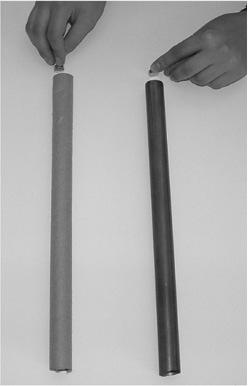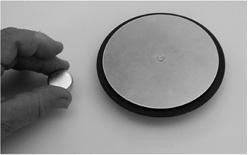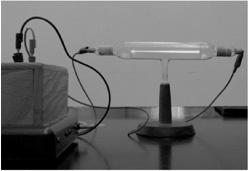125 Physics Projects for the Evil Genius (64 page)
Read 125 Physics Projects for the Evil Genius Online
Authors: Jerry Silver

Figure 108-1
A magnet moving through a coil of wire
.
The faster the relative motion between the magnet and the coil, the greater the current. The larger the number of coils—with all else equal—the greater the current. A more powerful magnet produces a greater current.
A magnetic field itself does not produce an electric current. A changing magnetic field is required to produce an electrical current. This is addressed in mathematical detail by Maxwell’s laws for those who want to pursue it further.
A nice way to display these results is to attach the coil to a voltage sensor and use this to generate a graph of voltage versus time. Moving the magnet back and forth in the coil results in an alternating current (AC). If you hang the magnet on a spring and have it oscillate up and down in the coil, you will have a simple model of an AC generator.
A good follow-up is to investigate a model electrical generator, which can also generate a similar AC current.
The significance of this project is to show how mechanical energy is converted into electrical energy. The key parts of an electrical generator are a magnet and a coil of wire. Electricity flows when the coil and magnet move relative to each other.
If copper is not magnetic, how can it affect a falling magnet? Lenz’s law
.
When a magnet moves near a conductor, electrical currents can be produced in the conductor. When currents circulate in a piece of bulk material, rather than a wire that forms a complete circuit, the currents are called
eddy currents
. These eddy currents are more like water swirling in a tide pool rather than flowing in a stream. Eddy currents can reduce the efficiency of electrical devices, such as transformers, because the circulating current results in a loss of power. Eddy currents have several uses, which include magnetic damping of sensitive meters, and they are used in magnetic braking for rapid transit trains. This project explores an aspect of eddy currents called Lenz’s law.
- 3 neodymium disc magnets
- copper pipe whose diameter is slightly larger than the magnet
- plastic pipe of similar dimensions
- Hold both pipes vertically.
- Check the magnetic attraction between the magnets and each of the pipes.
- Position the magnet over the open top of each of the pipes.
- Drop the magnet through the pipes at the same time.
- Compare how fast the magnets fall through each of the pipes, as shown in
Figures 109-1
and
109-2
.
The magnet falls through the plastic pipe faster than through the copper pipe.

Figure 109-1
Both magnets are dropped at the same time. The non-conductive tube is on the left
.

Figure 109-2
The magnet going through the non-conductive tube (on the left) emerges first
.
When a magnet moves with respect to a conductor (such as copper), it creates (induces) an electric current in the conductor. This current, in turn, produces a magnetic field. According to Lenz’s law, this magnetic field will be aligned in such a way that it is pointed in the opposite direction as the magnetic field that originally produced it. This results in an attractive force between the magnet and the copper pipe in which a current is induced by the falling magnet. Because the plastic is not conductive, no magnetic field is produced to create the Lenz effect.
One other way to do this is to use disc magnets with holes in their centers. Then, the magnets are placed over copper, plastic, and iron rods whose diameter is slightly smaller than the inner diameter of the hole in the magnet.
An aluminum disc is not magnetic. If the disc is spun and a strong magnet is brought near, eddy currents are produced whose effect is to slow the spinning disc. This is known as
magnetic braking
, and it is shown in
Figures 109-3
and
Figure 109-4
.
Lenz’s law describes how eddy currents are formed in a nonmagnetic material. These eddy currents interact with a magnet in a way that opposes the effect of that magnetic field.

Figure 109-3
A neodymium magnet is brought near a spinning non-conducting plate
.

Figure 109-4
Magnetic braking (and not friction) stops the plate
.
Effect of a magnet on an electron beam. The right-hand rule for magnetic force
.
One of the great accomplishments of physics in the twentieth century was the discovery of the electron by J. J. Thomson. In this project, you revisit some of the steps that led Thomson to his discovery.
- cathode ray tube (CRT)—this can be any tube-type video monitor (TV or computer). If you have access to an oscilloscope, you can use that. Liquid crystal display (LCD) or plasma screen displays do not have electron beams and will not work here. A stand-alone CRT (such as a Crooke’s tube available from scientific supply companies excited by an induction coil) can be used.
- strong magnet
- your right hand
- mini Post-it notes
1. CAUTION: If you are using a high-voltage induction coil to produce the electron beam in the CRT, be very careful not to touch the exposed terminals while it is operating. Be certain you
exactly
follow the manufacturer’s instructions for using this equipment.
2. Careful: It is typically not recommended to expose TV or computer screens to magnetic fields. Excessive or prolonged exposure can cause unintended damage.
3. Turn on the CRT.
4. Make any adjustments needed to focus the electron beam.
– For an oscilloscope, disable the vertical and horizontal sweeps, leaving a single dot at the focus
– With the computer, find a point of focus, including text or a period on the screen
– With the TV, find a stationary image to focus on
5. Identify the north pole of your electron magnet.
6. Bring the magnet near (but not touching) the CRT screen.
Expected Results7. Observe the effect of the magnet on the electron beam.
The magnetic field causes the electron beam to bend.
If the beam is moving
to your right
and the magnetic field, north to south, is pointed
inward
across the tube, the electron beam will be bent down. See
Figure 110-1
. (Note that since electrons have a negative charge, this is the
opposite
direction specified by
the right-hand rule
for positive charges.)
Figure 110-2
shows an electron beam moving from left to right in a cathode ray tube. In the absence of a magnetic field, the beam is horizontal.

Figure 110-1
Effect of a magnetic field on an electron beam
.

Figure 110-2
Cathode ray tube. Photo by S. Grabowski
.
If a magnetic field is placed across the beam (with the north pole indicated by tape in front), the beam is deflected downward as shown (by Steve Grabowski) in
Figure 110-3
.
If the magnetic field is reversed (so that the north pole is in the back) the beam is deflected upward as shown in
Figure 110-4
.